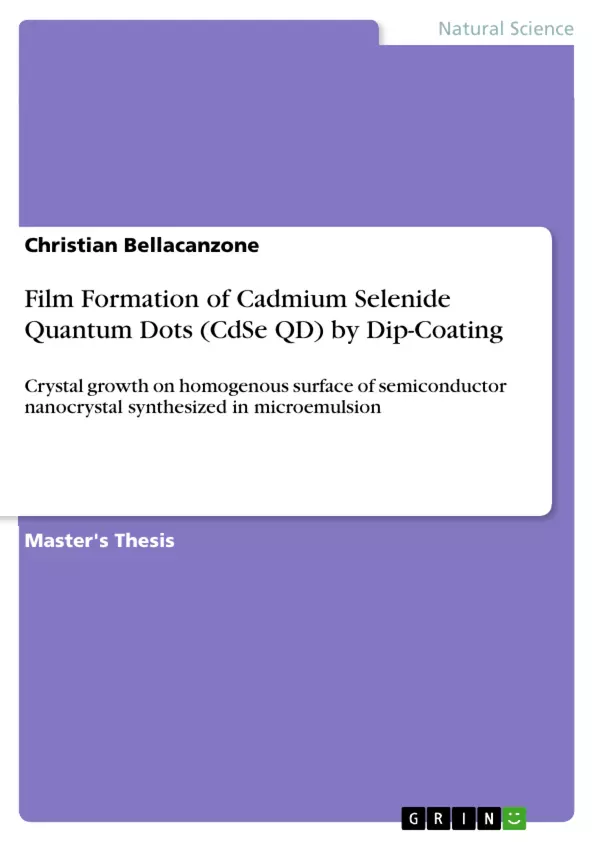In this work is presented the investigation on the morphology cadmium selenide quantum dots (CdSe QD) crystals, growth on glass substrates by dip coating. Two different samples have used for the film formation: one with CdSe QD and the second one with CdSe QD covered with the tripeptide L-glutathione. Both samples were synthesized using the technique of water-in-oil microemulsion, and the Dioctyl sulfosuccinate sodium salt (AOT) was used as the surfactant. The film obtained by the first sample (CdSe QD without stabilizing agent) shows the better properties: the pattern of the film is more regular and the striations are well defined with a square shape; moreover it exhibits a powerful fluorescence emission.
Furthermore, the dip-coating was carried out at different speed to verify if the film formation follows the theoretical prediction. The height of each film obtained at a different rate (using the first sample) was measured, and the results were compared with the theory using the Landau-Levich equation. It was verified a full correspondence between the experimental data and theoretical model.
Table of Contents
- AIM OF THE WORK
- CHAPTER 1: INTRODUCTION
- 1.1 Quantum Dot
- 1.2 Quantum Dots Synthesis
- 1.3 Dip Coating
- 1.4 Application
- 1.4.1 Tissue Regeneration
- 1.4.2 QD Solar Cells
- CHAPTER 2: EXPERIMENTAL PART
- 2.1 Materials
- 2.2 Preparation Methods
- 2.2.1 Synthesis Methods for CdSe qd
- 2.3 Coating Procedure
- 2.4 Characterization Techniques
- 2.4.1 Fluorescence Microscopy
- 2.4.2 Atomic Force Microscopy (AFM)
- CHAPTER 3: RESULTS AND DISCUSSION
Objectives and Key Themes
This thesis investigates the morphology of CdSe quantum dot crystals grown on glass substrates via dip coating. CdSe nanocrystals are synthesized in inverse micelles using the surfactant AOT, with and without the stabilizing agent L-glutathione. The study explores differences in film formation between these samples, aiming to determine which exhibits superior properties. The dip-coating process is performed at varying speeds to assess the film formation against theoretical predictions using the Landau-Levich equation. AFM and fluorescence microscopy are employed for morphological and dimensional analysis.
- Morphology of CdSe quantum dot crystal growth on glass substrates.
- Influence of L-glutathione as a stabilizing agent on film formation.
- Correlation between dip-coating speed and film thickness.
- Comparison of experimental results with the Landau-Levich equation.
- Analysis of film properties using AFM and fluorescence microscopy.
Chapter Summaries
Chapter 1: Introduction provides background on quantum dots, their synthesis methods (specifically focusing on microemulsions), the dip-coating technique, and potential applications in tissue regeneration and QD solar cells. It details the properties of quantum dots, including quantum confinement and tunable emission wavelengths. The chapter also introduces the theoretical basis of the dip-coating process and the Landau-Levich equation.
Chapter 2: Experimental Part describes the materials used (including CdSe QDs synthesized with and without L-glutathione), preparation methods (water-in-oil microemulsion), the dip-coating procedure, and the characterization techniques (fluorescence microscopy and AFM).
Chapter 3: Results and Discussion presents the experimental findings. It compares film morphology and fluorescence emission between the two samples (with and without L-glutathione), discusses the relationship between dip-coating speed and film height, and analyzes the correlation with theoretical predictions from the Landau-Levich equation. The chapter includes detailed AFM and fluorescence microscopy images, showing the differences in film structure and the influence of dip-coating speed on the morphology.
Keywords
CdSe quantum dots, dip coating, L-glutathione, film formation, microemulsion, Landau-Levich equation, fluorescence microscopy, atomic force microscopy (AFM), quantum confinement, nanocrystals, thin films, surface morphology, tissue regeneration, QD solar cells.
- Quote paper
- Christian Bellacanzone (Author), 2013, Film Formation of Cadmium Selenide Quantum Dots (CdSe QD) by Dip-Coating, Munich, GRIN Verlag, https://www.grin.com/document/950425



